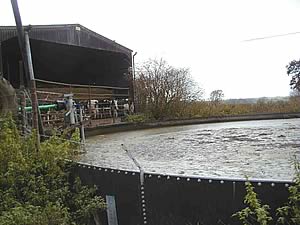15/05/06
Better management and more timely utilisation of slurries and manures will
help farmers and land managers meet new environmental legislation and cut
inorganic fertiliser costs, say IGER scientists.
IGER advises farmers to try and minimise the amount of diluted
slurry they have to store.
 |
“The industry needs a mindset change with regard to integrating fertiliser
and manure,” says senior research scientist John Laws from the Manures
and Farm Resources at IGER North Wyke. “The days of applying the full
complement of purchased nitrogen and then seeing slurry or FYM as a bonus nutrient
top up are gone. In fact, we must completely reverse this approach and measure
the supply of nutrients to the soil from manures and other organic materials,
such as grazing excretal deposits, first – and only then make up any
deficits with inorganic fertiliser.”
IGER North Wyke will be demonstrating this nutrient budgeting concept at a ‘Towards
a Better Farming Environment’ Open Day (in association with LEAF) on
Thursday 29th June 2006. The event is being held at the Devon Research Station
to mark 25 years of research at the site and will also give farmers practical
guidance on minimising nutrient and particulate losses from soils, meeting
the biodiversity goals of agri-environmental schemes, living with Nitrate Vulnerable
Zones (NVZs) and achieving the standards required by 2015 to stay within the
new Water Framework Directive.
John Laws says one of the biggest barriers to manure management change is the
lack of sufficient slurry storage on many farms. “The national average
is just two and a half months, but farmers really need an empty tank going
into winter and around four months storage capacity. That’s the first
step to more efficient slurry utilisation.”
IGER advises farmers to try and minimise the amount of diluted slurry they
have to store. “Additional water from parlour washings and rainfall on
cattle yards can easily double or even triple slurry volumes. Far better to
divert this dirty water to a separate store so that your slurry tank is freed
up. Then you’re in a much better position to assess how much storage
you will require for four months cover.”
John Laws points out that many farmers are applying slurry to grassland at
the wrong time, but this is largely a matter of necessity because the tank
is full. “Never spread in the autumn or early winter as you’ll
only create a pool of excess nutrients and nitrate leaching will be at its
maximum. Your aim should be to spread in the spring when the grass can take
up the nutrients and leaching will be low.”
Farmers are also often concerned about applying slurry early in the growing
season for fear of contaminating the grassland, but IGER says the new shallow-injection
and trailing-shoe application systems they are investigating will revolutionise
the practice. “These novel systems will give farmers a wider application
window and allow stock to graze the grass sooner. You can even get away with
spreading slurry on silage land within two weeks of cutting with no adverse
effects,” he says.
 IGER Open
Day To Highlight Route To A Better Farming Environment IGER Open
Day To Highlight Route To A Better Farming Environment
 Get
Fit For Spring, But Remember The Code! Get
Fit For Spring, But Remember The Code!
 Defra
to develop farm plastics scheme Defra
to develop farm plastics scheme
|


